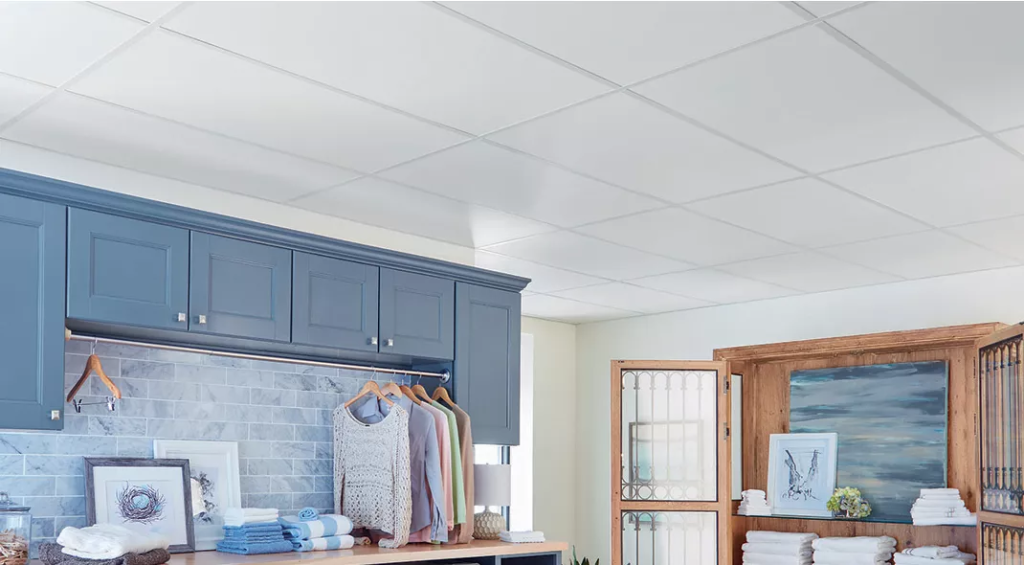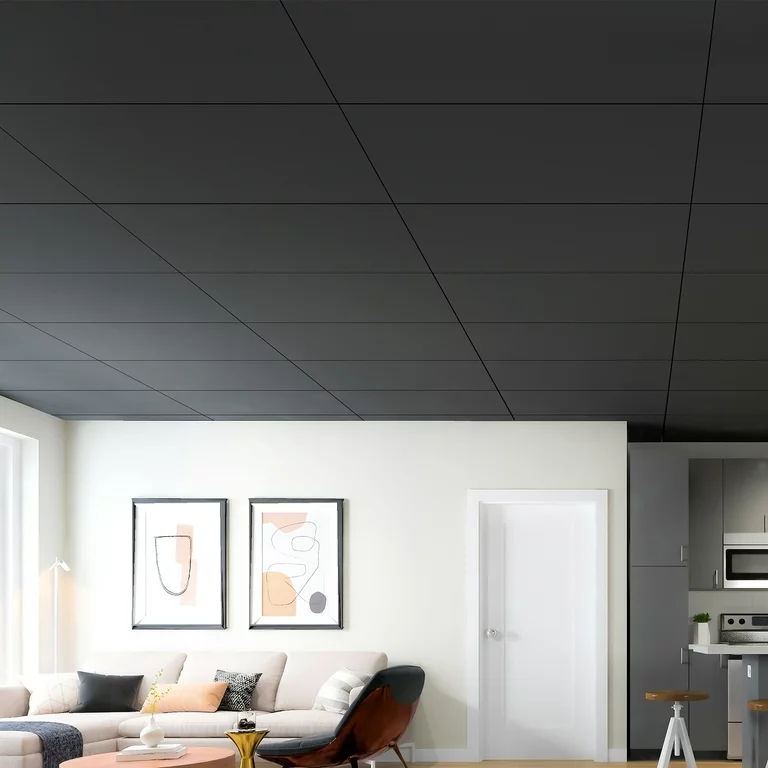Drop ceiling tiles, also known as suspended ceilings, have been a popular choice for commercial and residential spaces for decades. They offer a simple way to cover unsightly wires, pipes, and ductwork while providing easy access for repairs. Among the many options available, white drop ceiling tiles stand out as one of the most versatile and aesthetically pleasing choices for modern interiors.

In this article, we will explore everything you need to know about white drop ceiling tiles, including their benefits, different styles, installation process, and maintenance tips. Whether you’re renovating your home, office, or any other space, this guide will help you understand why white drop ceiling tiles might be the perfect solution for you.
What Are White Drop Ceiling Tiles?
White drop ceiling tiles are lightweight panels typically made of materials such as mineral fiber, gypsum, metal, or vinyl. These tiles are suspended from the actual ceiling using a metal grid system. The tiles rest inside the grid, creating a false ceiling that hides utilities like electrical wiring or air ducts while maintaining a clean and organized appearance.
White is the most common color for drop ceiling tiles, as it reflects light well, making spaces appear brighter and more open. Whether used in an office, retail store, basement, or kitchen, white drop ceiling tiles provide a neutral, minimalist look that complements virtually any décor.
Benefits of White Drop Ceiling Tiles
There are several reasons why white drop ceiling tiles have remained a popular choice for both commercial and residential properties. Below are some key benefits that make them a preferred option for many people:
1. Enhanced Aesthetic Appeal
White drop ceiling tiles offer a clean, streamlined appearance that enhances the overall look of any room. Their smooth, bright surface can make a room feel more spacious, which is especially important in areas with lower ceilings. In addition, the neutral color of white tiles can easily blend with a wide range of design schemes, from modern to traditional.
2. Light Reflection
One of the main advantages of using white tiles in a ceiling is their ability to reflect light. This can help reduce the need for additional lighting fixtures, making spaces appear brighter without consuming more energy. White drop ceiling tiles are ideal for offices, retail stores, and basements where natural light might be limited.
3. Sound Absorption
Many white drop ceiling tiles are designed to absorb sound, which is especially beneficial in noisy environments like open-plan offices or large conference rooms. These tiles help reduce echo and background noise, creating a more comfortable environment for conversations and work.
4. Easy Access for Maintenance
One of the greatest advantages of using drop ceiling tiles is the easy access they provide to important building systems. By simply lifting the tiles, you can access pipes, electrical wiring, and HVAC ducts for repairs or maintenance. This makes them an excellent choice for commercial buildings, where regular access to these systems is often required.
5. Concealment of Utilities
White drop ceiling tiles offer an elegant solution for hiding unsightly utilities like exposed wires, pipes, and ductwork. Instead of dealing with the messy appearance of these elements, drop ceiling tiles create a smooth and seamless surface, improving the room’s overall appearance.
6. Cost-Effective
Compared to other ceiling options, drop ceilings are relatively affordable. The installation process is quick and simple, reducing labor costs. Additionally, white drop ceiling tiles are available in a variety of price points, allowing you to find a solution that fits your budget without sacrificing quality.
Types of White Drop Ceiling Tiles
When choosing white drop ceiling tiles, it’s essential to understand that they come in various materials, designs, and finishes. Each type of tile offers unique features, so selecting the right one for your specific needs can make all the difference.
1. Mineral Fiber Tiles
Mineral fiber tiles are one of the most common types of drop ceiling tiles. Made from natural and synthetic materials, they are lightweight, affordable, and offer excellent sound absorption properties. These tiles are ideal for offices, classrooms, and other spaces where controlling noise levels is essential.
2. Gypsum Ceiling Tiles
Gypsum tiles are another popular option for white drop ceilings. Known for their durability and fire-resistant properties, they are a great choice for both commercial and residential spaces. Gypsum tiles tend to have a more solid and smoother surface compared to mineral fiber tiles, offering a polished look that works well in modern interiors.
3. Vinyl or PVC Tiles
Vinyl tiles are often used in areas with high moisture levels, such as basements, kitchens, or bathrooms. These tiles are water-resistant and easy to clean, making them a practical solution for spaces that require frequent maintenance. They come in a wide range of textures and patterns, adding more design flexibility.
4. Metal Ceiling Tiles
For a more industrial or contemporary look, metal ceiling tiles are an excellent choice. Metal tiles are incredibly durable, resistant to moisture and damage, and provide a sleek, modern appearance. While metal tiles can be more expensive than other materials, they offer a distinct aesthetic that works well in trendy commercial spaces or loft-style homes.
5. Acoustic Ceiling Tiles
Acoustic tiles are specifically designed to reduce noise levels in a room. They are often made from mineral fibers and feature perforations or patterns that enhance their sound-absorbing capabilities. These tiles are commonly used in theaters, offices, and music studios to improve acoustics.
How to Install White Drop Ceiling Tiles
Installing white drop ceiling tile is a relatively straightforward process, especially for DIY enthusiasts. Below is a step-by-step guide to help you install drop ceiling tiles in your home or office:
Step 1: Measure the Room
Begin by measuring the dimensions of the room to determine how many tiles and how much grid material you will need. It’s essential to account for any fixtures or obstacles in the ceiling, such as lights or vents, which may require adjustments to the grid layout.
Step 2: Install the Wall Angles
The next step is to install wall angles around the perimeter of the room. These angles serve as the support for the edges of the ceiling grid. Use a level to ensure the angles are straight, and secure them to the wall with screws or nails.
Step 3: Assemble the Grid
Once the wall angles are in place, assemble the metal grid that will hold the tiles. The grid consists of main runners, cross tees, and connectors. Follow the manufacturer’s instructions for assembling the grid, ensuring that it is level and properly aligned.
Step 4: Cut and Install the Tiles
If needed, cut the white drop ceiling tiles to fit around obstacles or along the edges of the room. Use a sharp utility knife to make clean cuts. Once the tiles are cut to size, simply drop them into place within the grid. Be careful not to damage the edges of the tiles during installation.
Step 5: Add Lighting or Fixtures
If you’re installing lights, fans, or other fixtures, ensure they are properly supported by the ceiling grid. You may need to reinforce certain sections of the grid to accommodate heavier fixtures.
Maintenance Tips for White Drop Ceiling Tiles
Maintaining your white drop ceiling tiles is essential to keep them looking clean and fresh for years to come. Here are some tips to ensure their longevity:
1. Regular Dusting
Over time, ceiling tiles can accumulate dust and dirt, especially in commercial spaces. Regularly dust your tiles using a soft cloth or vacuum with a brush attachment to keep them looking bright.
2. Clean Stains Immediately
If your white drop ceiling tiles become stained, it’s important to clean them as soon as possible. Use a mild detergent mixed with water to gently scrub the stained area. Avoid using harsh chemicals that could damage the surface of the tiles.
3. Replace Damaged Tiles
If a tile becomes cracked or discolored beyond repair, it’s best to replace it with a new one. Fortunately, drop ceiling tiles are easy to remove and replace without disturbing the rest of the ceiling.
4. Inspect for Moisture Issues
If you notice discoloration or sagging in your ceiling tiles, it could indicate a moisture problem above the ceiling. Inspect the area for leaks, and address any plumbing or roof issues promptly to prevent further damage.
Conclusion
White drop ceiling tile offer a practical and stylish solution for covering unsightly ceilings while providing easy access to utilities. Their ability to brighten up a space, combined with their sound-absorbing properties, makes them an excellent choice for both residential and commercial applications. With a wide range of materials, textures, and styles available, you can find the perfect white drop ceiling tile to suit your needs.
Whether you’re looking to improve the acoustics in your office, create a clean look in your basement, or hide imperfections in your ceiling, white drop ceiling tile provide a cost-effective and versatile option. By following proper installation and maintenance practices, you can enjoy a beautiful and functional ceiling for years to come.


